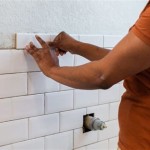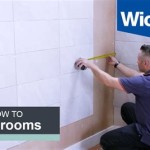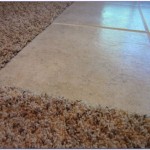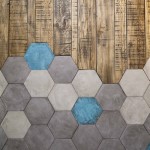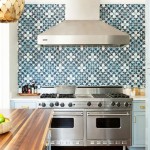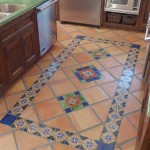Can You Put Tile On Drywall In a Bathroom? A Comprehensive Guide
The question of whether tile can be installed directly onto drywall in a bathroom is a common one, particularly for homeowners considering a DIY bathroom renovation or seeking cost-effective solutions. While it is technically possible in certain limited circumstances, the long-term viability and suitability of this approach depend heavily on several factors. This article will delve into the considerations, necessary preparations, potential drawbacks, and alternative solutions associated with putting tile on drywall in a bathroom environment.
The bathroom is a unique environment characterized by high humidity, frequent moisture exposure, and potential for water damage. These conditions place significant demands on building materials, particularly the substrate to which tile is adhered. Understanding the implications of these demands is crucial to making informed decisions regarding tile installation.
Drywall, also known as gypsum board, is a common wall covering material due to its ease of installation and relatively low cost. It consists of a gypsum core sandwiched between layers of paper. While drywall is suitable for many dry interior applications, its composition renders it vulnerable to moisture absorption. When drywall absorbs moisture, it can weaken, swell, and eventually crumble, compromising the integrity of the tile installation. This can lead to cracked grout, loose tiles, and potentially significant structural damage.
Directly tiling onto standard drywall in a bathroom is generally not recommended due to the inherent risks associated with moisture exposure. Standard drywall is not designed to withstand the constant humidity and potential water splashes that are typical in a bathroom. The paper facing of the drywall is particularly susceptible to moisture damage, making it an unsuitable substrate for tile, which requires a stable and waterproof base.
Key Point 1: Examining the Risks of Tiling Directly onto Drywall in a Bathroom
The primary risk of tiling directly onto drywall in a bathroom is the potential for moisture damage. As previously mentioned, drywall is porous and readily absorbs moisture. This absorption can lead to a cascade of problems that can significantly impact the lifespan and integrity of the tile installation.
One major concern is the weakening of the drywall itself. When drywall becomes saturated with water, the gypsum core can soften and lose its structural integrity. This weakening compromises the bond between the drywall and the tile adhesive, leading to tile slippage and eventually, tile failure. The expansion and contraction of the drywall due to moisture fluctuations can also create stress on the tile and grout, leading to cracks and further water infiltration.
Furthermore, trapped moisture behind the tile can create an ideal environment for mold and mildew growth. Mold and mildew not only pose health risks but also contribute to the deterioration of the drywall and other building materials. Addressing mold and mildew problems can be costly and disruptive, requiring removal of the affected materials and remediation of the underlying moisture source.
The type of tile being used also contributes to the overall risk. Larger, heavier tiles place greater stress on the substrate than smaller, lighter tiles. Heavier tiles require a stronger bond and a more stable substrate to prevent them from detaching over time. The use of improper adhesives can also contribute to tile failure. Choosing an adhesive that is not suitable for wet environments or that does not provide adequate bond strength can result in tiles separating from the drywall.
Improper or nonexistent waterproofing further exacerbates the problems. If the seams between the drywall sheets are not properly sealed, or if the tile installation lacks a proper waterproofing membrane, water can easily penetrate behind the tile and damage the drywall. The lack of proper ventilation in the bathroom can also contribute to moisture buildup, increasing the risk of damage to the drywall.
Another risk is the potential for costly repairs. If the tile installation fails due to moisture damage, the cost of repairing the damage can be significant. This may involve removing the existing tile, replacing the damaged drywall, and re-tiling the area. In some cases, the damage may extend beyond the immediate tile area, requiring repairs to framing or other structural elements.
Key Point 2: When Tiling on Drywall Might Be Considered (and the Necessary Precautions)
While generally not recommended, there are limited circumstances where tiling onto drywall might be considered, but only with significant precautions. These scenarios typically involve areas that are not directly exposed to water, such as a backsplash behind a vanity or a small decorative tile accent wall away from the shower or tub. However, even in these situations, careful consideration and adherence to best practices are crucial.
The first critical step is to ensure that the drywall is in excellent condition. It should be free from any signs of moisture damage, stains, or weakness. Any damaged drywall must be removed and replaced before proceeding with the tile installation. It is also essential to properly prepare the drywall surface by cleaning it thoroughly to remove any dust, dirt, or grease. A suitable primer should be applied to the drywall to improve adhesion and create a more uniform surface for the tile adhesive.
Using a moisture-resistant or mold-resistant drywall variety is highly recommended. These types of drywall are specifically designed to withstand higher levels of humidity and moisture exposure compared to standard drywall. While they are not entirely waterproof, they offer significantly better protection against moisture damage. Green board and blue board are common types of moisture-resistant drywall often used in bathrooms. Cement board is sometimes also referred to as "tile backerboard" which is the ideal option.
The selection of an appropriate tile adhesive is paramount. A high-quality, water-resistant thin-set mortar specifically designed for use in wet environments should be used. The adhesive should be applied according to the manufacturer's instructions, ensuring proper coverage and bond strength. Using an epoxy-based grout is also recommended, as epoxy grout is non-porous and highly resistant to water penetration.
Proper ventilation is essential to minimize moisture buildup in the bathroom. Ensuring that the bathroom has an adequate exhaust fan that is used regularly during and after showers or baths can help to reduce humidity levels and prevent moisture damage. The exhaust fan should be properly sized for the size of the bathroom and vented to the outside.
Even with these precautions, it is still important to monitor the tile installation regularly for any signs of moisture damage or tile failure. Inspect the grout lines for cracks and the tile surfaces for loose or discolored areas. Promptly address any issues that are identified to prevent further damage. Keep in mind any tiling done on drywall will be more prone to damage and less durable than tiling done on cement board.
Key Point 3: Superior Alternatives to Drywall for Bathroom Tile Installation
Due to the inherent limitations of drywall in bathroom environments, using alternative substrates specifically designed for tile installation is generally the preferred and most reliable approach. These alternatives offer superior moisture resistance, stability, and bond strength, ensuring a longer-lasting and more durable tile installation.
Cement backer board, also known as cement board, is widely considered the best substrate for tile in bathrooms. Cement board is a rigid, waterproof material made from cement and reinforcing fibers. It is highly resistant to moisture, mold, and mildew, making it an ideal choice for wet areas such as showers, tub surrounds, and bathroom floors. Cement board provides a stable and durable surface for tile adhesion, ensuring a long-lasting and trouble-free tile installation.
Another alternative is a waterproof membrane system. These systems typically consist of a liquid-applied or sheet-applied membrane that is installed over the drywall or another suitable substrate. The membrane creates a waterproof barrier that prevents water from penetrating behind the tile, protecting the underlying structure from moisture damage. Waterproof membrane systems are particularly useful in shower areas and other areas that are heavily exposed to water.
When installing cement board or a waterproof membrane system, it is essential to follow the manufacturer's instructions carefully. Proper installation techniques are crucial to ensure that the system performs as intended. This includes properly sealing the seams and corners of the cement board or membrane to prevent water infiltration. The use of the correct fasteners and adhesives is also essential.
For bathroom floors, using a self-leveling underlayment can provide a smooth and level surface for tile installation. Self-leveling underlayments are cement-based products that are poured onto the floor and allowed to harden. They can be used to correct minor imperfections in the subfloor and create a level surface for tile adhesion. Properly installed self-leveling underlayments enhance the stability and longevity of the tile installation.
Ultimately, the choice of substrate for bathroom tile installation depends on the specific requirements of the project, the level of moisture exposure, and the desired level of durability. While tiling onto drywall may be technically possible in certain limited situations with extensive precautions, utilizing alternative substrates like cement board or waterproof membrane systems provides a more reliable and long-lasting solution, mitigating the risks associated with moisture damage and ensuring the integrity of the tile installation.

Tile Over Drywall Showers A Common But Bad Practice Scott Hall Remodeling
Can You Put A Ceramic Wall Tile On Sheetrock For Basement Shower Quora

Replace Bathroom Drywall With Tiled Walls Fix It Handyman

Can You Reuse Drywall From Your Bathroom Remodel

Everything About Installing Tiles On Drywall

Shower Tile Installation Step By Four Generations One Roof

The Tile Journal Of Hamilton In Woodstock Ga

Waterproof Bathtub Shower Walls Over Drywall

Everything About Installing Tiles On Drywall

The Tile Journal Of Hamilton In Woodstock Ga
Related Posts

